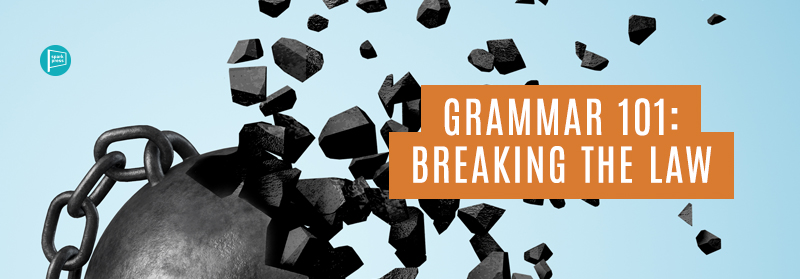
From an early age we’re taught that breaking the grammar laws is considered the biggest infringement of English as a written and spoken language. Grammar is taught as law, but what they don’t tell you is that all rules are meant to be broken. So let’s talk about fluidity and breaking the grammar laws we hold so dear:
1. Run-On Sentences
Definitions: Run-on sentences consist of at least two independent clauses that are connected in one sentence without proper punctuation.
THE RULE:
Sentences must be written using independent clauses, or combining independent and dependent clauses to create fully formed sentences.
WHEN TO BREAK IT:
When speaking or writing, we are told that run-on sentences are frowned upon. Breaking this rule is acceptable in writing under the pretenses of excitability or abruptness. When you are so excited you can barely contain it, using run-on sentences could emphasize this. Furthermore, in literary writing, many writers surpass punctuation to write in a “stream of consciousness” fashion. Notable writers who do this include James Joyce and Virginia Woolf.
2. Contractions
Definitions: A contraction is a shortened form of a group of words that omits certain letters or sounds. In most contractions, an apostrophe represents the missing letters. The most common contractions are made up of verbs, auxiliaries, or modals attached to other words.
THE RULE:
Never use abbreviated or shortened versions of words because it will make the writing informal.
WHEN TO BREAK IT:
Contractions are rarely used in formal writing. It is considered too casual. However, writing casually allows for casual diction. This will make your writing sound more fluid, especially during areas where heavy dialogue occurs.
3. Ellipses
Definitions: An ellipsis is a set of three periods ( . . . ) indicating an omission. Each period should have a single space on either side, except when adjacent to a quotation mark, in which case there should be no space.
THE RULE:
Only use an ellipses when omitting words in quotes.
WHEN TO BREAK IT:
An ellipses is typically used for omissions, but it can also be used to represent silences and when expressing thoughts. If a character trails off in thought, a dash or an ellipses is an excellent nonverbal indicator.
4. Dependent Clauses
Definition: A clause that provides a sentence element with additional information, but which cannot stand as a sentence.
THE RULE:
Never use a dependent clause without connecting an independent clause with it.
WHEN TO BREAK IT:
Breaking this law is okay when you are answering a question. In fiction writing, and especially during dialogues, if every sentence is restated, this could come off as wordy and robotic.
5. Diction
Definition: The choice and use of words and phrases in speech or writing.
THE RULE:
Use words that make you sound as professional as possible.
WHEN TO BREAK IT:
People often think that using more complex words makes them sound smarter, but it often comes off as very unnatural. Breaking this rule can make your writing sound more genuine, natural, and fluid. Furthermore, sometimes words have underlying connotations and meanings, and using them without full knowledge of the word can change the tone of what you are saying or writing.
6. Passive Voice
Definition: A passive voice construction is found in many languages. In a clause with passive voice, the grammatical subject expresses the object of the main verb – that is, the person or thing that undergoes the action or has its state changed.
THE RULE:
Never use a passive voice in writing.
WHEN TO BREAK IT:
Breaking this rule is hard to navigate, but acceptable when the thing receiving the action is more important than the action itself.
7. Conjunctions
Definition: A word used to connect clauses or sentences or to coordinate words in the same clause (e.g. and, but, if).
THE RULE:
Never use conjunctions in writing because it will compromise the professionalism of the work.
WHEN TO BREAK IT:
Starting a sentence with a conjunction is something that is generally frowned upon, but when answering a question or adding onto someone’s dialogue, it can make speaking and writing more natural and smooth.

Leave A Comment